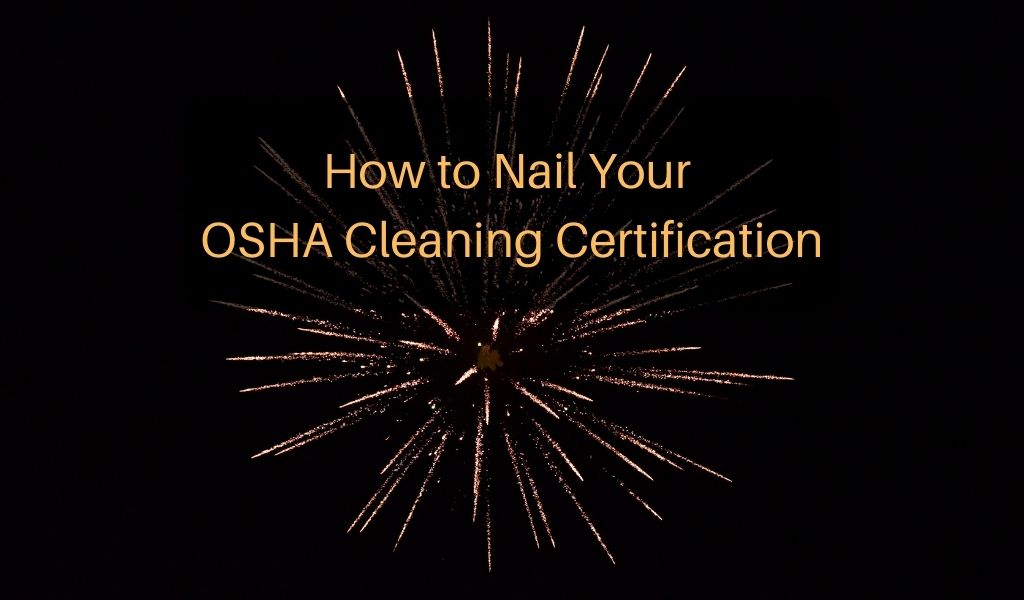Minimize risk liability and satisfy customers with OSHA cleaning certification to help keep everyone safe and healthy.
There are many ways a cleaning company can protect their employees, clients, and business safety and health from the many risks posed on any given job site. One of the best ways is to obtain OSHA cleaning certification. Sending your employees to OSHA-approved training can help to ensure that they’re aware of the standards and guidelines recommended by the administration and that they implement those standards on every job.
Obtaining OSHA cleaning certification isn’t necessarily simple, though. There are specific things employees need to know and understand to receive their OSHA cards. However, OSHA cleaning certification doesn’t expire once you pass the certification process. Although refresher courses are a good idea, especially when OSHA’s standards and guidelines change as they have recently amid the COVID-19 pandemic.
Several vendors offer OSHA-certified training courses, most of them are ten- and thirty-hour courses designed to ensure that your staff understands all of the basics about OSHA standards for the cleaning industry. While OSHA doesn’t offer training themselves, all the information you need to nail your OSHA cleaning certification is on their website at www.osha.gov. Here are some of the most important things to keep in mind.
Sign up for a free discovery call to learn about how Janitorial Manager can help with compliance and much more!

The 7 elements of OSHA cleaning certification (and why they are important to you)
The purpose of OSHA standards is to prevent workplace injuries, illnesses, and deaths, as well as the suffering and financial hardship these events can cause for employers and workers alike. According to their website, OSHA recommended practices will help prevent workplace injuries and illnesses, improve compliance with other laws and regulations, reduce costs, including workers’ compensation claims, engage workers, enhance everyone’s social responsibility goals, and increase overall productivity.
To address these issues, OSHA has broken safety management into seven different core elements, which we’ll look at now.
1. Management leadership
OSHA believes that all training starts with management leadership. This means that management provides the vision and resources necessary to maintain a safe and healthy work environment, including for those employees who work off-site, such as most in the cleaning industry. Worker health and safety should be a core organizational value. Management needs to set examples through their own actions by communicating their commitment to a safety program, outlining goals, setting aside resources and funds, and expecting a certain level of performance from their staff. While not explicitly required for OSHA cleaning certification, this step is crucial to employees engaging in OSHA training and taking it seriously not only for themselves, but for the business as a whole. Without leadership from the top down, it can be tough to run a cleaning business that is OSHA compliant.
2. Worker participation
Though business owners can lose a lot from lack of compliance, the workers themselves usually stand to lose the most if they don’t participate in programs designed to increase safety and health on the job site. Likewise, they may also have the most to gain from a successful program like OSHA cleaning certification, including helping to make programs run smoothly since they often already know many of the hazards present on any given job. Employee participation in your safety program is critical to its success, just as management leadership is. It’s important then to ensure that employees are encouraged to participate in safety programs and that they have access to information and programs designed to protect them.
3. Hazard identification and assessment
One of the most crucial components to achieving OSHA cleaning certification is understanding the hazards present on a job site and how to avoid them or minimize the risks they pose. Initial workplace assessments should be made to identify potential hazards, and employees should be trained on how to handle any given situation. Some of this can be done generally, such as training on products that might be dangerous on any job site, but some of it will be job-site specific.
4. Hazard prevention and control
Once hazards are adequately assessed, consider prevention and control mechanisms to help reduce the risk. Employers and employees both should identify potential control options and develop a hazard control plan that is shared company-wide, even with people who may be working on a different job site. It’s also important to keep emergency plans in place in the event of an incident. Once controls are implemented in the workplace, reassess them regularly to ensure that they are functioning correctly.
5. Education and training
Without proper education and training, it will be challenging to complete OSHA cleaning certification. Employees should be trained regularly on all OSHA standards and guidelines as well as any other regulatory policies that exist on the federal, state, and local levels. As mentioned, many vendors offer OSHA training that will result in receiving an OSHA card designating your employees as OSHA compliant. Of course, receiving training and implementing the learnings are two different things, but employees will only be set up to succeed if they have proper ongoing education.
6. Program evaluation and improvement
No safety and health program is perfect all the time, and the changing guidelines of OSHA and other agencies mean that programs need to be regularly reviewed and improved where necessary. Look at your programs once a quarter to ensure they are compliant with current regulations and that they’re providing the safety that they’re supposed to.
7. Communication and coordination for host employers, contractors, and staffing agencies
This last point is important in the cleaning industry because many host employers and contractors are often involved in cleaning services. Ensuring that these individuals know your policies and programs is an essential step in protecting everyone from potential workplace hazards. When all of these points are followed, you set yourself and your teams up for the greatest chance of success with OSHA compliance.
When OSHA cleaning certification is completed, it should be relatively straightforward to achieve these seven goals. And that can only help you, your team, and your customers work in a safer, healthier environment.
Set up a free consultation call to find out about all of the great features Janitorial Manager has to offer. Reach out any time, and we’ll schedule a call that suits your calendar!


I would like to take this Course